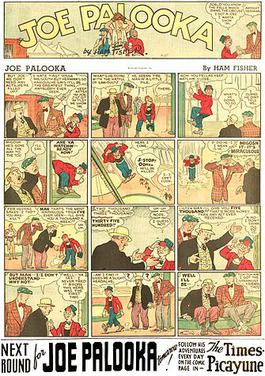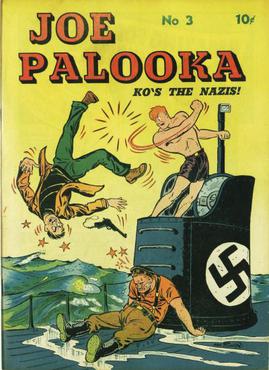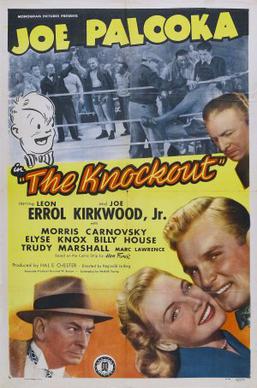Joe Palooka facts for kids
Quick facts for kids Joe Palooka |
|
|---|---|

Ham Fisher's Joe Palooka (June 25, 1939)
|
|
| Author(s) | Ham Fisher (1930–1956) Moe Leff (1956–1959) Morris Weiss (1959–1984) |
| Illustrator(s) | Ham Fisher (1930–1955) Moe Leff (1955–1959) Tony DiPreta (1959–1984) |
| Current status/schedule | Concluded daily & Sunday strip |
| Launch date | April 19, 1930 |
| End date | November 24, 1984 |
| Alternate name(s) | Joe the Dumbbell |
| Syndicate(s) | McNaught Syndicate |
| Publisher(s) | Columbia Comics Harvey Comics IDW Publishing |
| Genre(s) | sports, adventure |
Joe Palooka was a super popular American comic strip about a boxing champion. It was created by cartoonist Ham Fisher and first appeared on April 19, 1930. At its best, the comic strip was printed in 900 newspapers! The Joe Palooka comic strip ended in 1984.
Joe Palooka wasn't just a comic strip; he was a big star! His stories were made into a short radio show, 12 movies, and even a TV series. You could also find Joe Palooka on comic books, board games, watches, lunchboxes, and even on Wheaties cereal boxes. In 1980, a mountain in Pennsylvania was even named after the character!
Contents
Meet the Characters in Joe Palooka
The main character, Joe Palooka, was a kind and honest heavyweight boxing champion. His look often changed to match real-life boxing champs. But when Joe Louis, an African-American boxer, became famous in the 1930s, Joe Palooka's look stayed the same. He always had blond hair with a cowlick.
Joe's adventures were usually calm and simple. He had a great group of friends and family who helped him:
- Ann Howe: Joe's girlfriend, who later became his wife.
- Knobby Walsh: Joe's boxing manager.
- Little Max: Joe's quiet orphan sidekick.
- Smokey: Joe's valet and later his sparring partner.
- Humphrey Pennyworth: A friendly giant blacksmith who carried a huge 100-pound (45 kg) hammer.

Joe Palooka was meant to be a hero who showed good character, especially during World War II. He even helped cartoonists encourage people to buy Series E bonds to help pay for the war.
A big event in the comic strip happened on June 24, 1949, when Joe married his girlfriend, Ann Howe. The cartoonist, Ham Fisher, even sent out real invitations to famous people! He got replies from important figures like Chief Justice Fred M. Vinson and General Omar Bradley. At that time, the comic strip was in 665 American newspapers and 125 newspapers in other countries.
What Does "Palooka" Mean?
The word palooka was used as early as 1923. It meant someone who was clumsy or not a very good fighter. No one is completely sure where the word came from, but it might have come from the word polack, which was sometimes used as a slur.
Joe Palooka in Comic Books
Over many years, Joe Palooka appeared in comic books from different publishers. At first, these comic books just reprinted the newspaper strips. But later, new stories were created just for the comic books. Joe's friends, Little Max and Humphrey Pennyworth, even had their own comic book series from Harvey Comics.
More recently, Joe Antonacci brought Joe Palooka back to life! A new comic book version of the character was published in 2012 by IDW Publishing. In these new stories, Joe Palooka is a Mixed martial arts (MMA) fighter. Antonacci's team also created a related series of MMA comic books called Legion of Combat.
Joe Palooka on Radio, Film, and TV
Joe Palooka's adventures weren't just on paper!
Radio Series
A Joe Palooka radio show was on CBS from April 12 to August 18, 1932. Each episode was 15 minutes long and aired on Tuesdays and Thursdays. Teddy Bergman played Joe Palooka.
Films and Television
Joe Palooka first appeared in a movie called Palooka in 1934. Stuart Erwin played Joe, and Jimmy Durante played Knobby. You can even watch this movie online today because it's in the public domain!
After that, there were nine short films (called two-reelers) made between 1936 and 1937. Robert Norton played Joe, and Shemp Howard played Knobby.
Joe Palooka returned to full-length movies in 1946. Monogram Pictures made a series of 11 low-budget films starring Joe Kirkwood, Jr. as Joe, Leon Errol as Knobby, and Elyse Knox as Ann Howe. The first movie in this series was Joe Palooka, Champ (1946), and the last was Joe Palooka in Triple Cross in 1951.
In 1954, a TV series called The Joe Palooka Story (or just Joe Palooka) was released. Joe Kirkwood, Jr. played Joe again, and former boxing champion Maxie Rosenbloom played Humphrey Pennyworth.
Joe Palooka Movies
- Palooka (1934)
- Joe Palooka, Champ (1946)
- Gentleman Joe Palooka (1946)
- Joe Palooka in the Knockout (1947)
- Joe Palooka in Fighting Mad (1948)
- Joe Palooka in Winner Take All (1948)
- Joe Palooka in the Big Fight (1949)
- Joe Palooka in the Counterpunch (1949)
- Joe Palooka Meets Humphrey (1950)
- Joe Palooka in Humphrey Takes a Chance (1950)
- Joe Palooka in the Squared Circle (1950)
- Joe Palooka in Triple Cross (1951)
Vitaphone Short Films
These short films were made for Warner Brothers:
- For the Love of Pete (1936)
- Here's Howe (1936)
- Punch and Beauty (1936)
- The Choke's on You (1936)
- The Blonde Bomber (1936)
- Kick Me Again (1937)
- Taking the Count (1937)
- Thirst Aid (1937)
- Calling All Kids (1937)
All these shorts were directed by Lloyd French. Robert Norton and Shemp Howard starred in most of them.
Joe Palooka's Lasting Impact
Joe Palooka left a mark on American culture!
- South of Wilkes-Barre, Pennsylvania, there's a place called Joe Palooka Mountain. It was named in the early 1980s by the Mayor of Wilkes-Barre. You can find a granite monument with Joe Palooka's image at the base of the mountain.
- In September 1948, a large limestone statue of Joe Palooka was put on a hill in Indiana. In 1984, this nine-foot-tall, ten-ton statue was moved and rededicated to the Town Hall in Oolitic, Indiana.
- Joe Palooka is also mentioned in books and movies. For example, in the 1977 film Smokey and the Bandit, the character Cledus "Snowman" Snow says, "Look, you ain't gonna believe this, but I just did my imitation of Joe Palooka," after getting into a fight.
Images for kids
-
Joe Palooka plays golf with Bob Hope and Bing Crosby in a 1949 Joe Palooka strip by Ham Fisher and Moe Leff.
See also
 In Spanish: Joe Palooka para niños
In Spanish: Joe Palooka para niños






